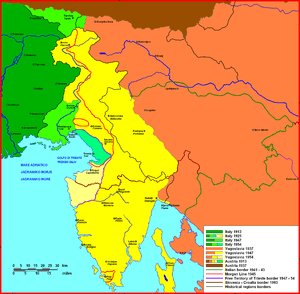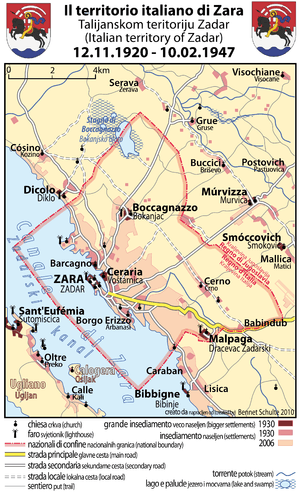Treaty of Rapallo (1920)
The Treaty of Rapallo was a treaty between the Kingdom of Italy and the Kingdom of Serbs, Croats and Slovenes (renamed Yugoslavia in 1929), signed to solve the dispute over some territories in the former Austrian Littoral in the upper Adriatic, and in Dalmatia.
 Map of the border changes in the Julian March: with the Treaty of Rapallo, Italy received most of the Austrian Littoral, part of Inner Carniola, and some border areas of Carinthia. | |
| Type | Peace Treaty |
|---|---|
| Context | World War I |
| Signed | 12 November 1920[1][2] |
| Location | Rapallo, Italy[1] |
| Condition | Arrangement of the border in Venezia Giulia and Free State of Fiume |
| Signatories | |
| Parties | |
| Language | Italian, Serbo-Croatian[1] |

The treaty was signed on 12 November 1920[3] in Rapallo, near Genoa, Italy. Tension between Italy and Yugoslavia arose at the end of World War I, when the Austro-Hungarian Empire dissolved and Italy claimed the territories assigned to it by the secret Treaty of London of 1915. According to the treaty signed in London on 26 April 1915 by the Kingdom of Italy and Triple Entente, in case of victory at the end of World War I, Italy was to obtain several territorial gains including former Austrian Littoral, northern Dalmatia and notably Zadar (Italian: Zara), Šibenik (Italian: Sebenico), and most of the Dalmatian islands (except Krk and Rab).
These territories had an ethnically mixed population, with Slovenes and Croats composing over the half of the population of the region. The treaty was therefore nullified with the Treaty of Versailles under pressure of President Woodrow Wilson, making void Italian claims on northern Dalmatia. The objective of the Treaty of Rapallo was to find a compromise following the void created by the non-application of the Treaty of London of 1915.
Content
At the conclusions of the discussions, the following territories were annexed to Italy:
- The western parts of the former Duchy of Carniola: more than half of the region of Inner Carniola, with the municipalities of Idrija (Italian: Idria), Vipava (Italian: Vipacco), Šturje (Italian: Sturie delle Fusine), Postojna (Italian: Postumia), Šent Peter na Krasu (Italian: San Pietro del Carso, now Pivka), and Ilirska Bistrica (Italian: Bisterza), and the Upper Carniolan municipality of Fusine in Valromana (Slovene: Bela Peč);
- The entire territory of former Austrian Littoral, except for the municipality of Kastav and the island of Krk, which were ceded to the Kingdom of Serbs, Croats and Slovenes;
- The former Dalmatian capital city of Zadar and the small Dalmatian islands of Lastovo and Palagruža.
According to the treaty, the city of Rijeka (Italian: Fiume) would become the independent Free State of Fiume,[4] thus ending the military occupation of Gabriele d'Annunzio's troops, begun by the Impresa di Fiume and known as the Italian Regency of Carnaro. This part of the treaty was revoked in 1924, when Italy and Yugoslavia signed the Treaty of Rome, which gave Fiume to Italy and the adjacent port of Sušak to Yugoslavia.
The treaty left a large number of Slovenes and Croats in Italy. According to author Paul N. Hehn, "the treaty left half a million Slavs inside Italy while only a few hundred Italians in the fledgling Yugoslav state".[5] Indeed, according to the 1910 Austrian census 480,000 South Slavs (Slovenes and Croats) became citizens of the Kingdom of Italy, while around 15,000 Italians became citizens of the new Yugoslav state (around 13,000 in Dalmatia, and the rest in the island of Krk). According to the same census, around 25,000 ethnic Germans and 3,000 Hungarians also lived in the regions annexed to Italy with the Treaty, while the number of Italians living in the region was between 350,000 and 390,000.
References
- "Treaty between the Kingdom of Italy and the Kingdom of the Serbs, Croats and Slovenes signed at Rapallo, 12 November 1920" (PDF). League of Nations, Treaty Series, vol. 18. League of Nations. 1923. pp. 397–403. Retrieved 20 November 2017.
- "Rapalski ugovor". Hrvatska enciklopedija (Croatian encyclopedia) (in Croatian). Miroslav Krleža Institute in Zagreb. Retrieved 20 November 2017.
- A Low Dishonest Decade by Paul N. Hehn; Chapter 2, Italy the Powers and Eastern Europe, 1918-1939. Mussolini, Prisoner of the Mediterranean
- Foreign Policies of the Great Powers by Cedric James Lowe, Routledge, Taylor & Francis Group, F. Marzari, p.177-78
- A Low Dishonest Decade by Paul N. Hehn; Chapter 2, Italy the Powers and Eastern Europe, 1918-1939. Mussolini, Prisoner of the Mediterranean
External links
| Wikimedia Commons has media related to Treaty of Rapallo (1920). |